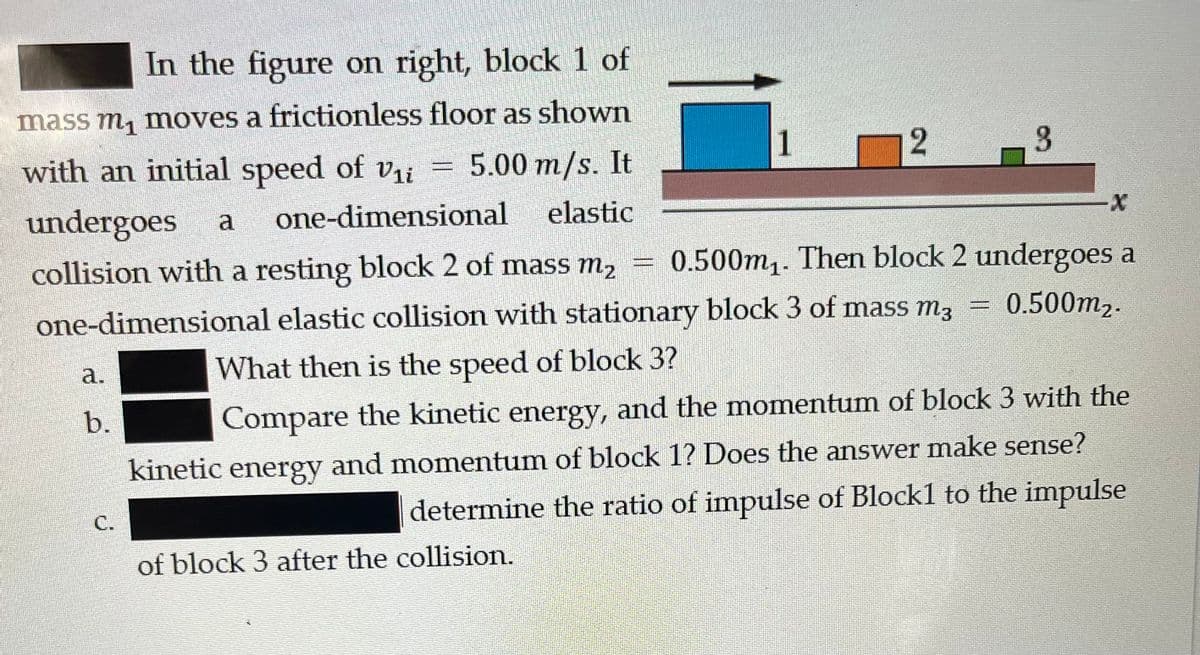In the figure on right, block 1 of ass m₁ moves a frictionless floor as shown with an initial speed of Vi 5.00 m/s. It elastic one-dimensional a ndergoes collision with a resting block 2 of mass m₂ = 0.500m₁. Then block 2 undergoes a 0.500m2. One-dimensional elastic collision with stationary block 3 of mass m² What then is the speed of block 3? a. b. 1 2 www. 3 -X Compare the kinetic energy, and the momentum of block 3 with the d momentum of block 1? Does the answer make sense?
In the figure on right, block 1 of ass m₁ moves a frictionless floor as shown with an initial speed of Vi 5.00 m/s. It elastic one-dimensional a ndergoes collision with a resting block 2 of mass m₂ = 0.500m₁. Then block 2 undergoes a 0.500m2. One-dimensional elastic collision with stationary block 3 of mass m² What then is the speed of block 3? a. b. 1 2 www. 3 -X Compare the kinetic energy, and the momentum of block 3 with the d momentum of block 1? Does the answer make sense?
Classical Dynamics of Particles and Systems
5th Edition
ISBN:9780534408961
Author:Stephen T. Thornton, Jerry B. Marion
Publisher:Stephen T. Thornton, Jerry B. Marion
Chapter9: Dynamics Of A System Of Particles
Section: Chapter Questions
Problem 9.36P: In an elastic collision of two particles with masses m1 and m2, the initial velocities are u1 and u2...
Related questions
Topic Video
Question

Transcribed Image Text:In the figure on right, block 1 of
mass m₁ moves a frictionless floor as shown
with an initial speed of V₁i 5.00 m/s. It
undergoes a one-dimensional elastic
collision with a resting block 2 of mass m₂ = 0.500m₁. Then block 2 undergoes a
0.500m₂.
one-dimensional elastic collision with stationary block 3 of mass m²
What then is the speed of block 3?
Compare the kinetic energy, and the momentum of block 3 with the
kinetic energy and momentum of block 1? Does the answer make sense?
determine the ratio of impulse of Block1 to the impulse
a.
b.
C.
of block 3 after the collision.
1
2
3
Expert Solution
This question has been solved!
Explore an expertly crafted, step-by-step solution for a thorough understanding of key concepts.
This is a popular solution!
Trending now
This is a popular solution!
Step by step
Solved in 2 steps

Knowledge Booster
Learn more about
Need a deep-dive on the concept behind this application? Look no further. Learn more about this topic, physics and related others by exploring similar questions and additional content below.Recommended textbooks for you

Classical Dynamics of Particles and Systems
Physics
ISBN:
9780534408961
Author:
Stephen T. Thornton, Jerry B. Marion
Publisher:
Cengage Learning

University Physics Volume 1
Physics
ISBN:
9781938168277
Author:
William Moebs, Samuel J. Ling, Jeff Sanny
Publisher:
OpenStax - Rice University

Classical Dynamics of Particles and Systems
Physics
ISBN:
9780534408961
Author:
Stephen T. Thornton, Jerry B. Marion
Publisher:
Cengage Learning

University Physics Volume 1
Physics
ISBN:
9781938168277
Author:
William Moebs, Samuel J. Ling, Jeff Sanny
Publisher:
OpenStax - Rice University